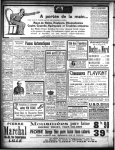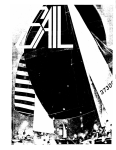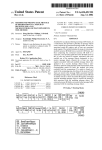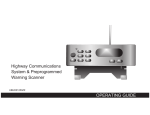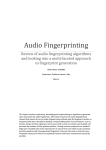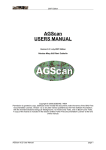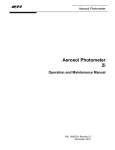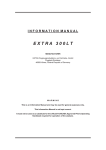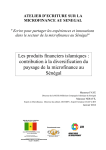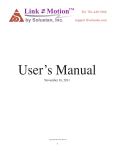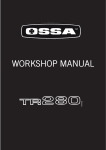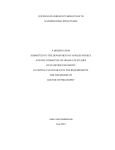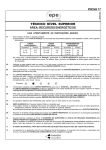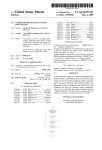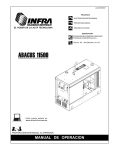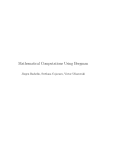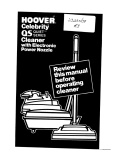Download Method for rule-based correction of spelling and grammar errors
Transcript
US006618697B1
(12)
United States Patent
(10) Patent N0.:
Kantrowitz et al.
(45) Date of Patent:
(54)
METHOD FOR RULE-BASED CORRECTION
0F SPELLING AND GRAMMAR ERRORS
(75)
Inventors: Mark Kantrowitz, Pittsburgh, PA (US);
5,537,317 A
5,559,693 A
5,572,423
(73)
.
Asslgnee: Justsystem Corporatlom Tokushlma
Notice:
{Twist
*
5,875,443 A
. ... .
. . . . . . ..
----
395/795
----
2/1998
Ar
'
..................... .. 434/169
2/1999 Nigllsnegn ................ .. 707/2
5,933,525 A *
8/1999 Makhoul et al.
6,182,039
*
1/2001
R'
Subject' to any disclaimer,~ the term of this
6,272,456 B1 *
8/2001
dégégggosa _ _ _ _ _ _
patent 1s eXtended 0r adlusted under 35
U.S.C. 154(1)) by 0 days.
6,292,772 B1 *
6,424,983 B1 *
9/2001 Kantrowitz
.. 382/230
7/2002 Schabes et al. .............. .. 704/9
B1
'
t
l.
382/185
.....
. . . ..
704/239
_ _ _ __ 7O4/8
OTHER PUBLICATIONS
(21) Appl. No.: 09/312,229
.
Church
8/1997 Golding
au e a.....................
.
.. 395/795
5,715,469 A
(JP)
( * )
11/1996
*
5,659,771
,
,
A
.
Sep. 9, 2003
7/1996 Schabes etal. .............. .. 704/9
9/1996 Anick et al. ......... .. 364/419.08
A
2
Shumeet BaluJa’
Waltham’ MA(US)
.
*
US 6,618,697 B1
_
“Techniques for Automatically Correcting Words in Text”
(22) Flled'
May 14’ 1999
Karen Kurkich, Dec. 1992 vol. 24 No. 4, ACM 0360—0300/
(51)
Int. Cl.7 ................................................ .. G06F 9/45
92/1200—0377.*
(52)
US. Cl. ............................... .. 703/22; 703/2; 704/8;
704/9; 704/239; 704/240
“Techniques for Automatically Correcting Words in TeXt”
Karen Kurkich, Dec. 1992 vol. 24 No. 4, ACM 0360—0300/
(58)
Field of Search ............................ .. 704/9, 10, 239,
22420941377-
*
704/240; 703/22, 2
(56)
References Cited
US. PATENT DOCUMENTS
_
_
5,
One time Complete Indexmg of Text: Theory and Practice
R.J. D’Amore, ACM 0—89791—159—8/85/006/0155, 1985*
“Recursive Hashing Functions for n—grams” J. Cohen, ACM
1046—8188/97/0700—0291, 1997.*
* cited by examiner
3,188,609 A
6/1965 Harmon et al. ........ .. 340/146.1
4,342,085 A
7/1982 Glickman et al.
2
4,674,065 A
3,1051“??? et a1‘
6/1987 Lange et al.
,
,
es
4,701,851 A
4,754,489
10/1987
A
6/1988
relc
. . . . . . . . .
Primary Examiner_Kevin J_ Teska
364/900
Assistant Examiner—Fred Ferris
(071). Agogwy’ Agegté or Firm Webb Zlesenhelm Logsdon
. . . ..
-
Bass et al. .
Bokser
364/300
364/419
.........
. . . ..
382/40
4,775,251 A
10/1988 Suzuki et al. ..
400/63
4777596 A
10/1988 Shaffer ct a1~ -
364/300
2
,
i/laklgl
,
0
4,868,750 A
ae
""""""""
e
a.
r 1“
ansom
-
-
~
(57)
ABSTRACT
A computer implemented method Which does not require a
stored dictionary for correcting spelling errors in a sequence
............ ..
9/1989 Kucera et al.
~
_
-
-
-
-
364/419
gf?woéds complnses stonng a Flurahtyhd Spelhng 9155
12/1991 Wilcox et al. .............. .. 382/39
Word and for replaclng an Illegal H-gram Wlth a legal H-gram
9/1992 Saito et al. ............... .. 434/167
to return a Corrected Word, submitting a Word from said
5,189,610 A
2/1993 Kaplan et al.
5,239,617 A
8/ 1993 Gardner et a1
sequence of Words to the spelling rules and replacing a Word
in the string of Words With a corrected Word.
4,915,546 A
5,060,154 A
4/1990 Kobayashi et al.
“V1991 Duncan’ IV_ ____ __
5,075,896 A
5,148,367 A
5,255,386 A
*
400/697
364/419
364/419
395/12
10/1993 Prager ............ ..
395/600
5,258,909 A
* 11/1993
5,467,425 A
* 11/1995 Lau et al. ................. .. 704/240
5,475,587 A
5,485,372 A
5,521,816 A
12/1995
Damerau et al.
Anick et al.
,6 “e as mg“ a? expresslons ,Or mat‘: mg a potenila y
lllegal n-gram Which may comprise less than all letters in the
............ ..
704/9
_
.. 364/419.08
_
1/1996 Golding et al. ...... .. 364/419.08
5/1996 Roche et al. ........ .. 364/419.08
Write candldate rules by hand or automatically as regular’
expression to match 'cmrecl one or more uncanghl error \n We
Corpus
Test candidate rule on large
dictionary to determine irii
Add characters to either
side ofihe candldale
captures legal \VUlLlS
rule [0 make more
Speci?c.
exception list
Apply heuristics io combine and
pinne rules.
Add candidate
rules (0 rule SOL
_
Mlcro?che Appendlx Included
(6 Micro?che, 493 Pages)
Collect corpus or spelling and typing CI'I‘OIS with die proper
correction [or eachv
Add anylcgal wnid to rule's
_
21 Clam“, 2 Drawmg Sheets
Too many exceptions”
U.S. Patent
Sep. 9, 2003
Sheet 1 0f 2
US 6,618,697 B1
Collect corpus of spelling and typing errors with the proper
correction for each.
Write candidate rules by hand or automatically as regular
expression to match/correct one or more uncaught error in the
corpus.
Test candidate rule on large
dictionary to determine if it
captures legal Words.
Add characters to either
4_ side of the candidate
rule to make more
specific.
Add any legal Word to rule’s
exception list.
Too many exceptions?
—>
l
Apply heuristics to combine and
prune rules.
l
Add candidate
rules to rule set.
Fig. 1
U.S. Patent
Sep. 9, 2003
Sheet 2 0f 2
US 6,618,697 B1
Text to be spell-checked
Set of regular-expression rules
and corrected
with one or more corrections
for each.
l
+
Scan through text looking for match to regular-expression
l
Found a match. Is the correction associated with this rule
unique?
YES. Correct the error.
NO. Present user with
multiple possible
corrections.
l
Apply correction
chosen by user.
.
/
Continue until
done.
Fig. 2
'
US 6,618,697 B1
1
2
METHOD FOR RULE-BASED CORRECTION
OF SPELLING AND GRAMMAR ERRORS
may comprise alternative characters, Wild card characters
and position indicators.
Brie?y, according to one embodiment of this invention,
there is provided a computer implemented method Which
MICROFICHE APPENDIX
does not require a stored dictionary of valid Words for
correcting spelling errors in a sequence of Words. The
Amicro?che appendix containing source code in the LISP
language is ?led herewith. It comprises 6 micro?che and 493
frames.
method comprises the steps of storing a plurality of spelling
rules de?ned as regular expressions for matching a poten
tially illegal n-gram Which may comprise less than all letters
in the Word and for replacing an illegal n-gram With a legal
COPYRIGHT NOTICE
n-gram to return a corrected Word. A Word from the
A portion of the disclosure of this patent document
contains material Which is subject to copyright protection.
The copyright oWner has no objection to the facsimile
reproduction by anyone of the patent document or the patent
15
disclosure, as it appears in the Patent and Trademark Of?ce
patent ?le or records, but otherWise reserves all copyright
According to another embodiment of this invention, there
is provided a method of correcting both spelling errors and
grammar errors. The method comprises storing a plurality of
spelling and grammar rules de?ned as regular expressions
rights Whatsoever.
BACKGROUND OF THE INVENTION
given the context of one or more adjacent Words. At least
tWo adjacent Words at a time from the sequence of Words are
submitted to the rules. If a corrected Word or sequence of
Although the availability of interactive spelling checkers
is Widespread, users do not like to use such systems because
they are tedious. Interactive spelling checkers ask the user
about any Word that does not appear in the dictionary, even
though most such Words are valid. Such dictionary-based
sequence of Words is submitted to the spelling rules. If a
corrected Word is returned, it is substituted for the mis
spelled Word in the sequence of Words. The method may
comprise submitting a corrected Word to at least one addi
tional rule.
25
corrected Words is returned, it is substituted in the sequence
of Words.
Preferably, an exception list is associated With each regu
systems also do not detect valid Word errors Where the user
lar expression or With the system as a Whole to prevent
accidentally substitutes one Word for another. Even When the
interactive systems do catch the errors (e.g., When the error
yields a Word that is not found in the dictionary), the
?rst-guess accuracy is loW, forcing the user to select the
correct Word from among a list of candidate alternatives. If
the systems Were to select the top-ranked candidate correc
n-gram replacement Where the Word matches an exception to
the rule. Preferably, the spelling rules match potentially
illegal n-grams comprising tWo or more characters. More
preferably, the spelling rules recogniZe and correct complex
types of errors in addition to simple insertions, deletions,
substitutions and transpositions.
tion for automatic substitution, the loW ?rst-guess accuracy
Would mean that more than half of the automatic substitu
tions Would be incorrect. Because of the extra effort
involved and the tedious nature of the user interfaces, many
35
spelling correction, optical character reader programs and
automatic handWriting recognition programs.
users decide not to use interactive spelling checkers.
Most preferably, the methods according to this invention
include storing spelling rules using multiple Words in con
SUMMARY OF THE INVENTION
text to identify spelling errors, confusable Words and com
The present invention addresses these problems With
mon grammar errors to identify a unique correction from
more than one possible correction or Word boundary errors
knoWn interactive spelling checkers. Since it has near
perfect ?rst-guess accuracy, it can automatically correct
comprising missing spaces, inserted spaces, shifted spaces
errors as the user types Without introducing neW errors. It
shifts the emphasis from recogniZing valid Words to recog
Applications of the methods disclosed herein include
Word processing programs that automatically correct errors
as the user types, Word processing programs With batch
45
niZing errors. Identifying the nature of the error often alloWs
correction of the error, even if there is no similar Word in the
and combinations thereof.
According to a preferred embodiment, the stored rules
include constraints based on case restrictions, parts of
valid Word dictionary. Although there are existing systems
speech, capitaliZation and/or punctuation appearing Within
based on dictionaries of common spelling errors and their
the sequence of Words.
The methods according to this invention may also include
associated corrections, these systems are limited to recog
niZing only the errors explicitly listed in the dictionary. The
a step for generating potential spelling rules de?ned as
typical error dictionary contains about a thousand of the
regular expressions comprising selecting as templates letters
most common errors. The present invention presents a
from errors in an error corpus and Zero or more letters of
rule-based method for detecting and correcting spelling and
context to identify a set of potential rules and the pruning
grammar errors. The invention is not guaranteed to catch all 55 from the set of potential rules those that are too general, too
errors, but those that it does correct are extremely likely to
speci?c or do not identify the cause of the error. NeW rules
be genuine spelling and grammar errors. Avariation of this
may be generated based upon the user’s manual corrections.
A further embodiment of this invention comprises a Word
completion method that is context sensitive comprising the
invention for handWriting recognition and optical character
recognition (OCR) improves the recognition accuracy of
such systems.
A “regular expression” is a computer programming con
struct that comprises an n-gram template to be matched
against a string of characters in a Word. The n-gram template
string may comprise less than all characters in the Word.
Matching the string either succeeds or fails. A matched
pattern may cause addition, deletion, transposition and/or
substitution of characters in the Word. The n-gram template
steps of storing a plurality of Word completion rules de?ned
as regular expressions for matching an n-gram Which may
comprise less than all letters in the Word and for replacing
a matched n-gram With an n-gram to complete the Word
given the context of one or more preceding Words. The
65
previous Word and n-gram comprising the initial letters of a
Word being typed are submitted to the rules. If a rule is ?red,
the Word being typed is completed automatically.
US 6,618,697 B1
4
3
In the folloWing examples of rules, the SS character sig
The present invention goes beyond the state of the art by
recognizing more than just isolated Whole-Word errors. It
uses rules that recogniZe error patterns and their associated
ni?es end of Word and the A character signi?es start of Word.
Any exceptions are listed after the rule in parentheses,
delimited by commas. Square brackets indicate that any of
the enclosed characters can appear in the given position,
con?ating What Would otherWise be several rules.
corrections. An error dictionary that contains only Whole
Words can correct only as many errors as are listed in the
dictionary. The rules used by the present invention can each
correct numerous common errors Without reference to a
valid Word dictionary. In essence, the present invention is
not just recogniZing the error, but also recogniZing the cause
of the error. This yields much more productive rules and,
hence, a more poWerful system.
The rules used by this invention are implemented by use
10
of regular expressions, case-restriction ?ags, space deletion,
insertion and shifting, and multiple Words of context
(including not just Whole Words and parts of speech, but also
regular expressions). This alloWs the system to correct errors
the anotherQthe other
corect—>correct
15
in a context-sensitive fashion, correct Word-boundary errors
and correct many valid Word errors. The present invention
can also correct many grammatical and lexical choice errors.
its aQit’s a
Aa$ A[aeio]—>an (AaSS, AoneElS, Aone-)
aWay formQaWay from
at there—>at their
Regular expressions used by this invention include not
just sequences of alphanumeric characters and start-Word
of ofQof
their seem—>there seem
and end-Word ?ags, but also more abstract patterns, such as
left and right handedness of the letters, sets of letters, and the
letter that corresponds to toggling another letter’s shift bit.
The regular expressions are not limited to just the letters
involved in the error, but can optionally include multiple
Aht—>th (html, http)
ierdQeird
Note that the “mnet” rule is restricted to Words Whose last
four letters are “mnet”, Whereas the “lierd” rule can include
Words in Which “ierd” appears in the middle, such as
25
letters of context on either or both sides of the error. The
“Wierdly”. Even the rule involving the misspelled Word
regular expressions are constructed to contain just enough
“corect” is general because it not only covers the pair
mapping corect to correct, but also the rule Will match and
context to uniquely identify the nature of the error and hence
the corresponding correction. This means that the rules
“corected”, “corection” and so on. If one Wanted to restrict
correct many more spelling errors, such as “corectly”,
generaliZe beyond the speci?c examples that motivated the
this rule to matching only Whole Words, one Would specify
rule, but are not so general as to introduce neW errors into
the constraint as “Acorect$”. Also note the “of of” rule, Which
corrects a common example of repeated Words. Other spell
correctly spelled text. It also means that the rules are not
limited to single insertions, substitutions, deletions and
ing checkers ?ag any example of repeated Words, even
transpositions, but can also handle other types of errors. It
though “nine one one” is not an error. The purpose of these
can handle transpositions of letters around one or more 35
rules is to only include errors that are certain to be incorrect,
letters, such as the transposition of consonants around one or
not ?ag all possible errors.
more voWels or the transposition of voWels around one or
The present invention does not correct all errors since
more consonants. The regular expressions are not limited to
some errors do not unambiguously specify their correction,
even given context information. In such cases, rules may
generate multiple candidate substitutions and alloW the user
to choose from among the candidate corrections. In any
event, the present invention can be used in combination With
bigrams or trigrams, but can be n-grams of any length. The
determining factor is the length needed to uniquely identify
the correction, not blind selection of all n-grams of a speci?c
length.
The rules used by this invention are bidirectional.
Normally, the only use for bidirectional rules Would be to
randomly introduce natural-seeming errors into correct text.
HoWever, the bidirectional rules are useful for “correcting”
45
betWeen British English and American English Without
traditional interactive spelling correction systems. One Way
is in parallel. The other Way is Where the correction proposed
by the present invention is listed ?rst in the set of candidate
corrections proposed by the interactive correction system. If
the user should choose not to use the interactive spelling
requiring a separate set of rules for each direction. If the user
correction system, the automatic spelling correction system
Will at least have improved the quality of their Writing
speci?es that he/she is Writing British English, the system
simply runs the rules that correct British English to Ameri
someWhat. Given the realities of user boredom and the
can English in reverse.
tedious nature of batch spelling correction systems, auto
Rule-chaining alloWs multiple errors to be corrected by
matic spelling correction Will improve spelling accuracy.
multiple rules, as Well as more complex spelling conven
tions to be represented by several rules.
The combination of multiple constraints improves the
According to another embodiment, the present error cor
rection method can learn from the user’s oWn corrections.
55
quality of the system. For example, f/v replacement Would
normally replace the Word “knife” With the Word “knives”
When adding the suf?x “s”. But When “knife” is used as a
verb, the Word “knifes” is acceptable. Thus, Whether the rule
identifying “ifes” as an error should apply depends on the
imputed part of speech of the affected Word.
The rules used by this invention may include lists of
exceptions Which may themselves be regular expressions in
addition to Whole Words. This often yields a signi?cant
reduction in the number of rules. It also makes it easier for
the user to override the operation of the system for particular
Words.
65
When the system detects the use of deletion or transposition
or insertion folloWed by or preceded by cursor movement, it
records the Word before the correction as Well as the result
of the user’s correction. In cases of multiple insertions,
deletions and transpositions, it Waits until cursor movement
moves outside the Word to initiate learning. If the error
resulted from the action of the automatic correction system
(i.e., the user undid the effects of the automatic correction),
the system adds the Word to an exception list for the rules
that generated the error. When the exception list for a rule
groWs too large, it triggers the rule induction system to re?ne
the rule. If the user did not undo a correction, the system
applies the rule induction system to generate a neW rule to
US 6,618,697 B1
6
5
address the error and similar errors in the future. Thus, the
system can adapt to the user’s oWn typing habits.
Since different errors may generaliZe to the same sets of
rules, duplicate rules are eliminated. Rules are also elimi
nated according to several heuristics. The number of times
According to yet another embodiment, the present method
may also learn from the user’s behavior in using the inter
the left-hand side of the rule matches errors in the error
corpus is examined. If more of the matches Would fail to
correct the error than successfully correct the error, the rule
active correction system. If the user made the same error
multiple times and alWays chose the same correction for the
error, the system may be con?gured to ask the user Whether
is discarded. This heuristic is equivalent to requiring the
it can add the error-correction pair to the automatic correc
ratio of successful to unsuccessful ?rings in the error corpus
tion system. If the user agrees, this Will trigger the rule
induction system.
Akey to the effectiveness of the present invention is hoW
the rules are produced. A large collection of spelling and
typing errors made by real people in a natural setting has
to be greater than 1, or that the unsuccessful ?rings represent
10
This latter ?gure is a tunable parameter. In some sense, it
re?ects the precision of the rule in correcting errors cor
rectly.
been gathered. The initial set of rules Were then Written by
hand, often inspired by speci?c examples from the error
The left-hand and right-hand sides of the rule are com
15
corpus. The rules Were tested in various Ways before being
added to the code. For example, a rule Was run on an 80,000
Word dictionary to verify that it does not introduce errors
into valid Words. If there are any exceptions, they must be
added to the rule or the rule discarded.
no more than 50% of the total matches in the error corpus.
20
pared With a large dictionary. If the left-hand side appears
more frequently than the right-hand side, the rule is dis
carded. This Would mean that the rule has more exceptions
than potential corrections and hence is not a very productive
rule.
If the number of times the rule successfully matches and
NeW rules, hoWever, may be generated automatically by
corrects an error in the error corpus is too loW, the rule is
one of tWo methods. The ?rst method tries to ?nd the rule
discarded. The goal of this heuristic is to have rules that
that maximally matches the error corpus While minimiZing
the number of exceptions. The second method is someWhat
more cautious in the generaliZations it accepts, requiring
rules to be statistically representative of the error corpus
from a generative perspective. This means that applying the
inverse of the rule to the dictionary should yield spelling
successfully account for as much of the error corpus as
possible (i.e., maximiZe the rule’s coverage of the corpus).
25
?re more frequently. This effectively minimiZes the number
of rules required to correct as many errors as possible. It also
errors With a similar distribution to that of the corpus. For
example, the ?rst method generated the rule
atii—>ati
to account for errors like “inspiratiion” and “generatiive”.
All of the errors in the error corpus that match “atii” end in
“ation” or “ative”. Applying the inverse of this rule to the
dictionary, hoWever, one ?nds that only half of the errors
generated by the inverse rule end in “ation” or “ative”. This
suggests that although the rule matches all of the errors, it
generaliZes beyond the cause of the spelling error. One needs
to add additional context characters to the rule in order to
limit it to just the cases that re?ect the nature of the error.
30
maximiZes the likelihood that the rules re?ect general types
of errors, instead of just memoriZing the speci?c errors
found in the error corpus.
If the number of times the right-hand side of the rule
matches Words in the dictionary is too loW, the rule is
35
discarded. The goal of this heuristic is to have rules that can
potentially correct a very large number of possible errors.
After all, if a rule can correct only one potential error, it
Would be better to list that error explicitly than to use a rule.
40
If the number of times the rule matches the errors in the
corpus but fails to successfully correct the error is too large,
the rule is discarded. The goal of this heuristic is to obtain
rules that pinpoint the nature of the error precisely. Failing
Caution is needed in developing rules for an automatic
correction system because no dictionary can be complete.
For example, most dictionaries do not include personal and
family names. The present invention is able to correct
to correct errors successfully is an indication of a poor
spelling errors in names Without introducing any neW errors. 45
It is desired to minimiZe the likelihood of a rule causing an
error While still maximiZing the number of errors it can
correct. In an interactive correction system Where one Wants
to identify possible errors Without 100% ?rst-guess
accuracy, the ?rst of the tWo systems is to be preferred
because of the greater generality of the rules it generates.
Given that the corpus represents a sample of the distribution
of errors in real life, rules that match more of the corpus Will
50
quality rule. A rule that makes many mistakes Will require
not just exceptions that correspond to Words in the
dictionary, but also exceptions that correspond to errors. The
number of such exceptions should be minimiZed to reduce
the complexity of the rules.
If the number of times the left-hand side of the rule
matches Words in the dictionary is too high, the rule is
discarded. The goal of this heuristic is to minimiZe the
In the ?rst rule-design method, each error from the error
likelihood that the rule Will introduce errors into Words that
are correct. Such Words must be included in an exception list
corpus generates many potential rules by including Zero or
for the rule, and such exception lists must be kept short. If
more characters on either side of the point of the error. Each
the exception list is too long, it is an indication of a poor
time a character is added on the left-hand side of the rule, the 55 quality rule. This effectively minimiZes the number of
corresponding character is added to the right-hand side of
the rule. For the purpose of rule generation, rules are thought
of as simply a multiple-character substitution pair. This
encompasses all major types of spelling errors, including
insertions, deletions, transpositions, transpositions around a
exceptions to the rules.
If the left-hand side of the rule matches the right-hand side
of the rule, it is discarded. The reason for this heuristic is that
character and, of course, substitutions. For example, the
transposition “ie” becoming “ei” after “c” can be repre
such rules match the results of applying a correction, and so
Will not terminate if applied iteratively. Such a rule Would
have to include the right-hand side on its exception list.
(This heuristic is redundant because such rules Will fail the
sented as the multiple-character substitution “cie”—>“cei”.
second heuristic listed above.)
Similarly, the deletion of “e” in “geing” can be represented
as the multiple-character substitution “geing”—>“ging”.
Rules can have Wildcards, negation and disjunction, but this
is not handled in the initial rule-generation phase.
60
If tWo rules correct the same collection of errors, the rule
65
With the loWer ratio of exceptions to right-hand side dictio
nary matches is preferred. The purpose of this heuristic is to
eliminate rules that are too general.
US 6,618,697 B1
8
7
It is important to limit the number of rules in applications
This method can also provide a deterministic procedure
for generating a rule from an example error. One starts With
the smallest possible rule and adds characters to the left
Where memory is at a premium, such as hand-held comput
ers like the “Palm Pilot”. The “Palm Pilot” has only 1 Mb of
memory, so We had to limit the number of rules to ?t in about
and/or right of the pattern (e.g., via a dynamic programming
5%—6% of the memory. (A dictionary based spelling cor
rection system Would require 1 Mb just for the dictionary.)
After the rules are pruned, a ?xed number “n” of the rules
Will be selected. The goal is to select the n-element subset of
rules Which maximiZes the coverage of the rules (the number
of error-correction pairs accounted for in the error corpus)
While minimiZing the number of exceptions. This is accom
algorithm) until the resulting rules are no longer discarded as
unacceptable. This gives a “fringe” of possible rules that can
be evaluated by the rule preferences described above.
BRIEF DESCRIPTION OF THE DRAWINGS
10
plished using stochastic search methods.
Another rule-design method comprises optimiZing a dif
ferent measure of rule collection quality, such as maximiZing
the dictionary coverage of the right-hand side of the rules
While minimiZing the number of exceptions or minimiZing
15
rule length, or maximiZing the error corpus coverage of the
left-hand side of the rule. Another rule-design method com
FIG. 1 is a diagram illustrating the generaliZed procedure
for developing a set of regular expressions useful according
to this invention; and
FIG. 2 is a diagram illustrating a generaliZed application
of regular expression rules to correct text according to this
invention.
DESCRIPTION OF THE PREFERRED
EMBODIMENTS
prises using a greedy algorithm to incrementally add rules to
the collection based on their incremental impact on collec
tion quality. As errors are added to the error corpus, they are
to the rule collection. If a rule does not fail any of the
The use of regular expressions to detect and unambigu
ously correct spelling and grammar errors With very high
accuracy is not limited to just the letters involved in the
pruning tests and increases the dictionary coverage of the
collection Without adding too many exceptions, it is added
error, but may include any number of letters of context on
either or both sides of the error. Not only can this method
examined to determine What rules, if any, should be added
to the collection. In other Words, if a neW rule is of suf?cient 25 recogniZe and correct the traditional types of errors (e.g.,
quality and does not overlap too much With the current rule
collection, it is added to the collection. The shortest rules are
single insertion, deletion, substitution and transposition
most preferred.
The second rule design method is similar in design to the
types of errors, such as long distance transpositions (e.g.,
errors), but it can also recogniZe and correct more complex
transposition of tWo consonants around a voWel and tWo
voWels around a consonant, as Well as Spoonerisms) and
?rst method but adds a feW more pruning rules. The number
of times the right-hand side of the rule matches corrections
cyclical letter shifts (e.g., movement of a letter forWard or
backWard tWo or more positions, as in “bWackard”). The
in the error corpus is examined. The rule is inverted and
applied to the correction to generate an error Which is then
regular expressions may include n-grams of any length and
compared With the actual error. If the ratio of the number of
are not restricted to n-grams of a speci?c length. Regular
times the generated error matches the actual error to the
expressions may be used to recogniZe exceptions to spelling
35
number of times it does not is less than one, the rule is
This latter ?gure is a tunable parameter. In some sense it
and grammar correction rules. Multiple Words of context
may be used to identify and automatically correct valid Word
spelling errors, confusable Word errors, such as its/it’s, and
re?ects the degree to Which the rule is a generative expla
common grammar errors. The use of multiple Words of
nation for the source of the error (i.e., a measure of the
degree to Which the error distribution in the error corpus
nonWord spelling errors Where the correction Would nor
discarded. This is equivalent to requiring the rule to account
for at least 50% of the corrections it matches in the corpus.
context may be used to identify and automatically correct
mally be ambiguous. The use of additional context alloWs
the system to restrict the possible corrections to a unique
correction. The use of multiple Words of context may also be
re?ects the action of the rule).
Rules are evaluated by comparing them With the result of
adding a character of context to either side of the patterns.
Three sets are formed. The ?rst set contains all dictionary
45
used to identify and automatically correct Word boundary
errors, such as missing spaces, inserted spaces and shifted
spaces. The rules may include other constraints, such as case
Words that match the right-hand side of the rule. The second
set contains all errors that match the left-hand side of the
rule. A subset of the ?rst set is obtained by examining Which
restrictions, parts of speech restrictions (e.g., “knifes” is
letters appear one character to the left of the left-hand side
corrected to “knives” only When the Word is a noun, not
When the Word is a verb) and restrictions on the types of
pattern in the Words in the second set, and ?nding all
elements of the ?rst set that match the extended patterns.
These elements are joined by the Words in the ?rst set that
match the characters that appear one character to the right of
the left-hand side pattern in the Words in the second set.
Together these Words form the third set. If the ratio of the
number of elements in the third set to the number of
elements in the ?rst set is less than 75%, the rule is discarded
as being too general. In essence, this heuristic measures the
generative coverage of the rule relative to the dictionary,
punctuation Which may appear betWeen the Words (e.g.,
sentence and phrase-?nal or not).
One method of generating regular expression rules for
spelling correction uses the errors in an error corpus and one
55
general (i.e., Which include valid Words Within their scope),
too speci?c (i.e., Which do not include many similar errors
Within their scope) or Which do not re?ect the underlying
cause of the error (i.e., Which generaliZe the errors in a
fashion Which might lead the rules to introduce errors into
novel Words not present in the dictionary that Was used to
requiring the distribution of errors in the error corpus to be
close to the distribution that Would be predicted by applying
the inverse of the rule, at least in an aggregate sense. If there
generate the rules).
The regular expressions may include not just speci?c
is a large (more than 25%) group of dictionary Words Whose
corresponding errors do not have representatives in the error
corpus, this suggests that the rule does not correctly account
for the cause of the errors by generaliZing the errors too
much.
or more letters of context to generate potential rules and then
uses a variety of heuristics to prune rules that are either too
65
letter patterns and Word boundary identi?ers (e.g., Word start
and Word end), but more abstract patterns such as: the keys
adjacent to the letter “s”, the letters typed on the left hand,
US 6,618,697 B1
9
10
the letters in the middle tWo columns of the keyboard, the
gemination consonants (letters than can be doubled) and the
letter Which results from toggling another letter’s shift bit
(e.g., the digit 9 appears on the same key as the left
rection code. The correction code Will return neW corrected
Words if the preceding Words need to be corrected. If so,
AUTOCORRECT substitutes the neW Words for the original
Words in the text.
parenthesis).
The rules may be bidirectional. This alloWs the rules to be
run in reverse. One application is the generation of error
(defun autocorrect (&0ptional char)
?lled text. Another application is correcting British English
to American English and vice versa, Without requiring a
separate set of rules for each direction. Word completion can
be thought of as a specialiZed application of spelling cor
;; This function grabs the Word and passes it to the
correction code.
10
rection. Although there is considerable prior art for Word
completion, there is no prior art for context-sensitive Word
;; If the correction code changes the Word, it
substitutes the neW Word.
(interactive)
(if autocorrect-mode
(if (and *undid-correction" (not
completion Where one or more Words of context can be used
*alloW-redo-of-undos"))
to identify the unique completion When the Word fragment
Would otherWise be ambiguous if taken in isolation.
Likewise, there is no prior art for phrase completion Where
a Word fragment (or even Whole Word or Words) is replaced
With a phrase. Both of these applications are easily repre
sented Within the framework of this invention. The rules
may be executed in parallel or serial order. The present
invention alloWs for any number of rules to be executed,
;; Reset the ?ag to indicate that no correction has
(setq *made-correction" nil)
;; The call to Word-end must be before the call to
Word-start.
20
;; We set END to the minimum of the position and
Word-end to
;; have it Work correctly if you type a space inside
a Word.
simpler rules.
candidate corrections based on general methods that yield
unlikely corrections in addition to the actual corrections.
Hard-coding the candidate corrections for the most common
spelling errors With ambiguous corrections Will yield a
(let ((position (point)))
been made.
alloWing multiple errors to be corrected in the same Word, as
Well as alloWing more complex errors to be decomposed into
Where there is not a unique correction, context is used to
reduce the number of candidate corrections and/or the
hard-coding of a list of candidate corrections for the most
common spelling errors. The prior art generates a list of
(setq *undid-correction" nil)
15
(let* ((end (min position (Word-end)))
(start (Word—start))
(Word (bufstring start end))
25
(prev-end (prev—Word—end))
(prev-start (prev—Word—start))
(prev (bufstring prev-start prev-end))
(replacement nil)
(prev-replacement nil)
tmp)
30
;; The purpose of this is to have a quick response
spelling correction system that seems more accurate to the
time When
user because it eliminates the spurious choices. Standard
methods of candidate generation may be used to provide an
over. We only
;; all We’re doing is hitting the spacebar to tab
;; Want to do the corrections When We hit the
initial list and add missing Words and delete spurious Words
from the list, as Well as ?xing the order of the Words in the
35
spacebar Within
;; or near the end of a Word.
(if (space-situation position end)
(setq replacement nil)
list. The user’s oWn manual corrections to the text of the
document may be used to generate correction rules.
The present invention uses patterns that match not just the
actual error, but suf?cient context to provide certainty that
the potential error is indeed an error. This permits the present
invention to unambiguously determine the correct alterna
(setq replacement (corrected-replacement Word
prev»)
;; (setq replacement (veri?er Word))
40
tive so that the rules may execute automatically as the user
types. The present invention also alloWs other attributes and
constraints in addition to Whole Words and parts of speech,
(if (consp replacement)
(progn
(setq tmp replacement)
(setq replacement (car tmp))
(setq prev-replacement (car (cdr tmp)))))
;;
phrase ?nal punctuation, space deletion for multiple-Word
(replace-region start end replacement
position t
(string-equal Word
rules and a list of exceptions for each rule. The exceptions
may be speci?ed as regular expressions and as Whole Words.
This makes the present invention more poWerful and
compact than other spelling correction systems. For
replacement))))
50
example, only 30 rules are necessary to correct the differ
ences betWeen British and American spelling conventions.
This requires signi?cantly less space and executes much
Word pairs.
prev—replacement))))
(if (or replacement prev-replacement)
The invention described herein has been implemented in
LISP source code. The entire program listing has been
included in the micro?che appendix. LISP is a Well-knoWn
language Which is described, for example, in LISP Second
Edition by Patrick Henry Winston and Berthold Klaus Paul
source code includes over 850 lines of code, over 550 lines
(if prev-replacement
(setq position
(replace-region prev-start prev-end
prev-replacement
position nil
(string-equal prev
faster than a system Which lists all of the more than 8,000
Horn, Addison-Wesley Publishing Company (1984). The
(setq replacement (veri?er replacement))
(if replacement
(setq position
such as case restrictions, the existence of sentence and 45
(goto-char
(setqposition))))
*made-correction"
(if (and char (char-equal char 10))
(insert-char 10 1)
(self-insert-command 1)) ; (insert “ ”)
60
(if *highlight-corrections"
) (unhighlight-region (— (point) 1) (point)))
of regular expression rules and over 20,000 lines of single
and multiple Word rules. What folloWs is a brief guide to the
major functions that execute corrections including a short
explanation folloWed by the actual LISP code.
AUTOCORRECT is a function that grabs a copy of the
immediately preceding Words and passes them to the cor
CORRECTED-REPLACEMENT. This function is called
by AUTOCORRECT to attempt a correction. First, it looks
for case errors, such as those that might result from a failure
US 6,618,697 B1
11
12
to release the CAPSLOCK key (e.g., typing “tHIS” instead
of “This”). It then corrects single-Word errors resulting from
_C0ntinued
slang usage, British English usage, multi-Word errors and
common spelling errors. Finally, it applies the spelling
COI‘I‘GCIlOIl rules.
5
The folloWing variables contain the indicated rules:
slang-corrections
Slang
uk-vs-us
British Spelling
rnulti Word-corrections
Multiple Word Errors
autocorrections
Common Spelling Errors
missing-spaces
Word Boundary Errors
spell-rules
uk-vs-us-rules
Regular Expression Rules
Regular Expression Rules
for British Spelling
1O
_
_
The last tWo variables are of the greatest interest. The
CORRECT-REPLACEMENT code folloWs:
(defun corrected-replacement (Word &optional prev)
;; This function does the actual correction.
(let ((replacement Word)
(prev-replacement nil)
(original-case (original-case Word))
(original-case-prev (if prev (original-case prev)))
corrected-case)
(progn
(let ((result (?x-capslock Word ?xed—prev—capslock)))
(if result
(progn
(setq ?xed-prev-capslock t)
(setq corrected-case result))
(setq ?xed-prev-capslock nil)))
(let ((result (?x-case-errors Word)))
(if result (setq corrected-case result)))))
;; The canonical rule order should be:
;; Slang, British, Multi Word, Single Word, Rules
;; Slang
(if *correct-slang"
(setq replacement (or (autocorrect-Word" replacement slang-corrections)
replacement)))
;; British Spelling
(if *correct-british-spelling*
(setq replacement
(or (autocorrect-Word" replacement uk-vs-us)
replacement)))
;; Fix Multiple Word Errors
(let ((tmp (correct-multi Word replacement prev rnulti Word—corrections)))
(if tmp
(progn
(setq replacement (or (car tmp) replacement))
(setq prev-replacement (car (cdr tmp))))))
;; Single Word
(setq replacement
(or (autocorrect-Word" replacement
(?nd-correction replacement autocorrections))
replacement))
;; Spelling Rules
(setq replacement (execute-spell-rules" replacement spell—rules))
;; British Spelling Rules
(if *correct-british-spelling*
(setq replacement (execute-spell-rules" replacement uk—vs—us—rules)))
;; Single Word correction again.
(setq replacement
(or (autocorrect-Word" replacement
(?nd-correction replacement autocorrections))
replacement))
;; Single British Correction Again
(if *correct-british-spelling*
(setq replacement
(or (autocorrect-Word" replacement uk-vs-us)
replacement)))
;; Fix Multiple Word Errors Again
(let ((tmp (correct-multi Word replacement (or prev-replacement prev)
rnulti Word—corrections)))
(if tmp
(progn
(setq replacement (or (car tmp) replacement))
(setq prev-replacement (or (car (cdr tmp)) prev—replacement)))))
US 6,618,697 B1
14
13
-continued
;; Fix Missing Spaces
(setq replacement (or (autocorrect-Word" replacement missing-spaces)
replacement))
;; Fix Name Case
(setq replacement (or (casecorrect-Word replacement case-corrections)
replacement)))
(if piglatin-mode
(setq replacement (piglatin replacement)))
(if replacement
(setq replacement (correct-case Word replacement (or corrected-case
original—case))))
(if prev-replacement
(setq prev-replacement
(correct-case prev prev-replacement original—case—prev)))
(if (string-equal replacement Word)
(setq replacement nil))
;; Return results
(if prev-replacement
(list replacement prev-replacement)
replacement)))
AUTOCORRECT-WORD is used to correct single Word
errors, such as slang, British spelling and common spelling
errors. These rules are simple Word-for-Word substitutions. 25
As We generate regular expression rules, We delete the
Word-for-Word substitutions that match the regular expres
sion rules. The AUTOCORRECT-WORD code follows:
replace the previous and current Word. If speci?ed as “”, the
Word is deleted. If speci?ed as nil, the Word is left alone.
“delspace” is a boolean that indicates Whether the space
between the previous and current Words should be deleted.
“case-sensitv” is a boolean that indicates Whether the rules
are case sensitive or case insensitive. Here are examples of
30
actual rules. The ?rst rule shoWs hoW a regular expression
multi-Word rule can be used to perform name completion.
(defun autocorrect-Word" (Word corrections)
(let ((result (autocorrect-Word Word corrections)))
(if (or (not result) (string-equal result Word))
Using this rule, typing a ?rst name and the ?rst three (or
more) letters of a last name, the rule replaces the latter With
result
(or (autocorrect-Word result corrections)
a full last name When the spacebar is touched. The A symbol
35
result))))
that the letters Kan must be at the beginning of the Word. The
(defun autocorrect-Word (Word corrections)
(let (pair
t indicates a regular expression rule, the ( ) indicates no
exceptions. The nil indicates that the space betWeen the ?rst
left right tmp
found case-sensitive)
(While (and corrections (not found))
40
(setq pair (car corrections)
corrections (cdr corrections))
(setq left (car pair)
;; test Was (string-equal-ci left Word)
((“Mark” “AKan” t (
(“Mark” “KantroWitZ” nil))
loose/lose.
45
((?loose” ?work”) (“105617 “Wor 17))
Similarly, a set of six rules relates to the its/it’s distinction.
found))
50
CORRECT-MULTIWORD is used to correct multiple
Word errors. It iterates over the list of rules, looking for rules
that match the current and previous Word. If there is a match,
it applies the rule to correct either or both Words (as
indicated by the rule). The format of the rules is as folloWs:
and last names is retained:
A simpler rule can be used to correct errors involving
right (car (cdr pair))
case-sensitive (car (cdr (cdr pair))))
(if (if case-sensitive
(string-equal left Word)
(string-equal-ci left Word))
(setq found right)))
in the rule is from a regular expression syntax, and speci?es
((“its”
((“its”
((“its”
((“its”
((“its”
((“its”
“a”) (“it’s” “a”)); 224 examples
“the”) (“it’s” “the”)); 88 examples
“an”) (“it’s” “an”)); 24 examples
“that”) (“it’s” “that”)); 10 examples
“there”) (“it’s” “there”)); 7 examples
“here”) (“it’s” “here”)); 2 examples
((ptest Wtest regexp-test exceptions) (prepl Wrepl delspace)
The comments after each rule indicate the number of
examples of this error found in a corpus containing about
case-sensitv); “ptest” and “Wtest” are tests applied to the
previous and current Word; “regexp-test” is a boolean that
2,000 uses of its or it’s.
For a more complex rule, look at one of the rules for
speci?es Whether ptest and Wtest are compared using simple
string equality or using a regular expression match. (If nil,
string-equal is used; if T, regular-expression match function
string-match is used.) “string-equal” is provided since some
rules do not require the full complexity of regular
expression match. “exceptions” is a list of exceptions to
“Wtest”. The exceptions are alWays compared using a regu
lar expression match. “prepl” and “Wrepl” are strings used to
55
correcting a/an errors:
60
“Ahour” “AheirElS” “Aherb”)) (“a” nil))
This rule says that the Word “an” folloWed by a Word
beginning With a voWel or letter h, except Where the Word
65 that folloWs is a single letter or one of a small set of
exceptions, is replaced With the Word “a”. The CORRECT
MULTIWORD code folloWs:
US 6,618,697 B1
15
16
(defun correct-multiWord (Word prev &optional rules)
(let ((found nil)
rule Wtest ptest regexp-test exceptions Wrepl prepl delspace case-sensitive)
(if prev
(While (and rules (not found))
(setq rule (car rules))
(setq rules (cdr rules))
;; format is
;; ((ptest Wtest regexp-test exceptions) (prepl Wrepl delspace) case-sensitv)
(setq ptest (car (car rule))
Wtest (car (cdr (car rule)))
regexp-test (car (cdr (cdr (car rule))))
exceptions (car (cdr (cdr (cdr (car rule)))))
prepl (car (car (cdr rule)))
Wrepl (car (cdr (car (cdr rule))))
delspace (car (cdr (cdr (car (cdr rule)))))
case-sensitive (car (cdr (cdr rule))))
(if (if case-sensitive
(and (string-equal Word Wtest)
(string-equal prev ptest))
(and (string-equal-ci Word Wtest)
(string-equal-ci prev ptest)))
;; Was (not (member Word exceptions))
(if (not (matches-exception Word exceptions regexp—test))
(setq found (list Wrepl prepl))))
(if (and regexp-test (not found)
(string-match Wtest Word)
(string-match ptest prev))
;; Was (not (member Word exceptions))
(if (not (matches-exception Word exceptions regexp—test))
(setq found (list Wrepl prepl))))
(if (and found delspace)
(setq found (list “ ”
(format “%s%s”
(or (car (cdr found)) ; prepl
prev)
(or (car found) ; Wrepl
word>>>>>
found))
EXECUTE-SPELL-RULES function is used to apply the
regular expression rules. The format of the rules is as
These correct common suf?x transpositions. The rule
(“oualy” ( ) 0 3 “ous”) corrects a/s substitution errors
When folloWed by the -ly suffix (this kind of substitu
folloWs: (constraint exceptions offset Width substitution
case) “constraint” is a regular expression that matches the
Word. “exceptions” is a list of regular expressions that
tion error is much more common in that context). The
rule
should match any exceptions to the rule. “offset” and
“Width” specify the portion of the Word to be deleted, if any.
(“blity” ( ) 0 5 “bility”) is an example of correcting a
deletion error, and
(Width Would be 0 if no text Were to be deleted. If the entire
Word Were to be deleted, Width Would equal the Word’s
length.) “substitution” is a string that is inserted at the
rects a common spelling error (forgetting to delete the
silent e When adding the suf?x “ing”). We can also stick
in the u that folloWs q if the user forgets it
position indicated by offset. “offset”, incidentally, is relative
to the ?rst position Where constraint matches the Word, not
the beginning of the Word. For example, here is a rule that
corrects one of the more common s/Z replacement errors that
A rule to correct common semicolon-apostrophe substi
occur With British spelling:
tution errors (e.g., “I;d” instead of “I’d”) reads,
(“[aeiouy][dmnrtl]ising” (“Aarising$” “Ademising$” “pr
[oe]mising”) 3 1 “Z”)
The constraint looks for a voWel or y folloWed by one of
55
ending in -cied, -cier, etc):
that We do not include the end-of-Word symbol SS after
“ising”, so this rule should also match Words that end in
(“cie” (“scien[ct]” “societ ancient” “hacienda
“cie[drs]” “ciety” “cien[ct]”) 0 3 “cie”
“isingly” or other characters beyond “ising”. The exceptions
Additional rules correct for ei/ie transposition errors, such as
list rules out four exceptions to this rule. Since We are using
O-based indexing, the 3 indicates an offset to the letter “s”.
The 1 indicates one character to be deleted (the s), and a “Z”
is substituted.
Other example rules include:
The
(‘2dr
“i before
(“hm”)
e except
0 1 after c” rule has many more excep
tions than targeted in school (e.g., science, society, Words
the consonants dmnrtl, folloWed by the string “ising”. Note
(“mnet$” ( ) 0 4 “ment”)
(“toin” (“dittoing” “vetoing”) 0 4 “tion”)
qadi”
50
(“[Ac]eiv” ( ) 1 2 “ie”); believe, mischievous (Here [Ac]
means not c.)
Rules for f/v replacement should probably be restricted
according to part of speech, since knife+s becomes knives
65
When knife is a noun, but knifes When knife is a verb. To do
so Would require integrated part-of-speech tagging as part of
this system. We implemented such rules using multi-Word
US 6,618,697 B1
17
18
rules (e.g., knife preceded by “the” is a noun) Without
part-of-speech tagging.
2. A computer implemented method Which does not
require a stored dictionary for correcting spelling errors and
Rules to handle missing space errors, such as the omission
of space after a close-parenthesis, may include:
(“) [a—Z] ”
1 0“ ”)
The EXECUTE-SPELL-RULES code folloWs:
adjacent Word grammar errors in a sequence of Words, said
method comprising the steps of:
5
a) storing a plurality of spelling and grammar rules
pretested for exceptions de?ned as regular expressions
(defun execute-spell-rules" (Word &optional rules)
(let ((result (execute-spell-rules Word rules)))
(if (or (not result) (string-equal result Word))
result
(or (execute-spell-rules Word rules)
result))))
(defun execute-spell-rules (Word &optional rules)
(let (rule
constraint exceptions offset Width substitution case
result)
(While rules
(setq rule (car rules))
(setq rules (cdr rules))
(setq constraint (car rule))
(setq exceptions (car (cdr rule)))
(setq offset (car (cdr (cdr rule))))
(setq Width (car (cdr (cdr (cdr rule)))))
(setq substitution (car (cdr (cdr (cdr (cdr rule))))))
(setq case (car (cdr (cdr (cdr (cdr (cdr rule)))))))
(let ((position (string-match constraint Word)))
(if (and position
(not (matches-exception Word exceptions t))
(or (not case) (string-equal Word (doWncase Word))))
(progn
(setq position (+ position offset))
(let ((leftpart (substring Word 0 position))
(rightpart (substring Word (+ position Width))))
(setq result (format “%s%s%s” leftpart substitution rightpart))
(if result
(setq Word result))
DD)
Word))
As used in the foregoing speci?cation and in the folloWing claims, a “regular expression” comprises an n-gram
for matching potentially illegal n-grams some of Which
comprise less than all letters in a Word and given the
template to be matched against a string of characters in a 40
Word- The n'gram template smug may Comprlse 1655 than an
Context of one or more adjacent Words replacing an
illegal n-gram With a legal n-gram to return a corrected
characters in the Word. Matching the string either succeeds
Word;
or fails. A matched pattern may cause addition, deletion
and/or substitution of characters in the Word. The n-gram
template may comprise alternative characters, Wild card 45
Characters and position indicators_
Having thus de?ned our invention in the detail and
particularity required by the Patent Laws, What is desired
protected by Letters Patent is set forth in the folloWing
Clalms- _
We claim:
50
1. A computer implemented method Which does not
require a stored dictionary for correcting spelling errors in a
sequence of Words, said method comprising the steps of:
a) storing a plurality of dictionary pretested for exceptions 55
spelling rules de?ned as regular expressions for match
ing potentially illegal n-grams some of Which comprise
b) submitting at least tWo adjacent Words at a time from
said sequence of Words to said rules; and
c) replacing a Word in the sequence of Words With a
Corrected Word,
Wherein an exception list is associated With at least one
regular expression or with the System as a whole to
prevent n-gram replacement Where the Word matches
an exception to the rule.
3. The method according to claim 1 or 2, comprising
storing spelling rules Which match potentially illegal
n-grams comprising tWo or more characters.
4. The method according to claim 1 or 2, comprising
storing spelling rules that recogniZe and correct complex
less than all letters in a Word and for replacing an illegal
types of errors in addition to simple insertions, deletions,
Substitutions and transPOsitiOnS
n'gratp with a legal n'gram to return a Corrected Word;
5. The method according to claim 1 or 2 that automatically
b) submitting a Word from said sequence of Words to the 60 Corrects errors as the user types
Spelling rules; and
6. The method according to claim 1 or 2 that batch process
c) replacing a Word in the string of Words With a corrected
Corrects errors,
WOrd,
7. The method according to claim 1 or 2, that corrects a
Wherein an exception list is associated With at least one
text ?le input by an optical character reader.
regular expression or With the system as a Whole to 65
8. The method according to claim 1 or 2, that recogniZes
prevent n-gram replacement Where the Word matches
error in a text ?le input from an automatic handWriting
an exception to the rule.
recognition system.
US 6,618,697 B1
19
20
9. The method according to claim 1, wherein the spelling
rules use multiple Words in context to identify spelling
prising the steps, some of Which are implemented by a
programmed computer, of:
a) generating spelling rules de?ned as regular expressions
errors, confusable Words and common grammar errors.
10. The method according to claim 1, Wherein the spelling
for matching illegal n-grams some of Which comprise
rules use multiple Words in context to identify a unique
correction from more than one possible correction.
less than all letters in a Word and for replacing an illegal
n-gram With a legal n-gram to return a corrected Word,
11. The method according to claim 1, Wherein the spelling
rules use multiple Words in context to correct Word boundary
said step of generating spelling rules comprising select
errors.
ing as templates letters from errors in an error corpus
12. The method according to claim 12, Wherein the Word
10
boundary errors are selected from the group comprising
missing spaces, inserted spaces, shifted spaces and combi
nations thereof.
13. The method according to claim 9, 10 or 11, Wherein
that are too general, too speci?c or do not identify the
cause of the error;
b) storing said set of spelling rules de?ned as regular
the context Words are de?ned by regular expressions.
14. The method according to claim 1 or 2, Wherein the
expressions;
c) submitting a Word from said sequence of Words to the
rules include constraints based on case restrictions.
15. The method according to claim 1 or 2, Wherein the
rules include constraints based upon parts of speech.
16. The method according to claim 1 or 2, Wherein the
rules include constraints based on capitaliZation and/or
punctuation appearing Within the sequence of Words.
17. The method according to claim 7, Wherein letter
confusion matrices are used to generate potential rules.
18. The method according to claim 1 or 2, Wherein a
corrected Word is submitted to at least one additional rule.
19. A method Which does not require a stored dictionary
for correcting spelling errors in a sequence of Words com
and one or more letters of context to identify a set of
rules pretesting and pruning from the set of rules those
spelling rules; and
25
d) replacing a Word in the sequence of Words With a
corrected Word.
20. The method according to claim 19, Wherein neW rules
are generated based upon the user’s manual corrections.
21. The method according to claim 1 or 2, Wherein the
rules are stored in any one of hash tables, tries, linear lists
and ?nite state automata.













